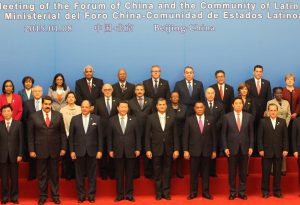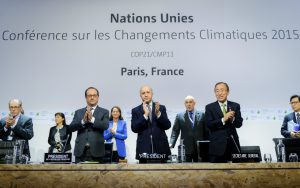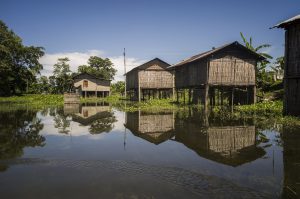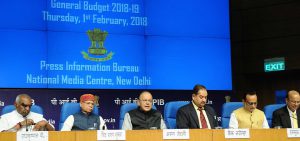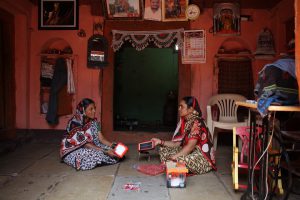The world has changed dramatically in the past three years, outgoing Chilean President Michelle Bachelet told the second ministerial meeting of China and the Community of Latin American and Caribbean States (CELAC-China) in the capital Santiago on Monday.
When the inaugural triennial meeting between China and the 33-nation Western hemisphere bloc took place in Beijing in January 2015, there was no Paris Agreement on climate change; no 2030 Sustainable Development Agenda; and a return to economic protectionism was unimaginable, Bachelet said.
Since that first meeting the forum has made progress on environmental cooperation, said Heraldo Muñoz, Chile’s foreign minister. “We’re supporters of multilateralism, of governing to face problems like climate change and natural disasters together,” said Muñoz.
China has also greatly increased its international presence through the Belt and Road infrastructure initiative (BRI). The project took centre-stage at this year’s CELAC-China Forum. Parties released the Declaration of Santiago, which identifies environment as one of eight priority areas for “mutual benefit and development”; and made a formal declaration on Latin America’s new role in the BRI. A more detailed Cooperation Plan for 2019 – 2021 is expected soon.
The first China-CELAC forum announced the 2015-2019 Cooperation Plan, with President Xi Jinping grabbing headlines worldwide by pledging to invest US$250 billion in the region and increase trade to US$500 billion within the next decade. Expectations on how the partners would follow such big commitments loomed large in Santiago.
New path, or enduring obstacles?
Delivering a message from Chinese President Xi, foreign minister Wang Yi said that CELAC has become the main channel for overall cooperation with Latin America and for achieving “great outcomes”.
In the old cooperation plan, the forum declared its intention to establish numerous sector-specific fora, including on infrastructure, science and technology, and cultural exchanges.
The creation of a dedicated platform for environment – a subject that has at times strained relations between China and Latin America – would be a step in the right direction, according to Fernando Reyes Matta, director of the Latin American Centre for China Studies (CELC) and a former Chilean ambassador to China.
“We’ve begun to create spaces for reflection between China and CELAC on such themes as environment,” said Reyes Matta, also highlighting that the new declaration also includes a paragraph on working towards the 2030 Sustainable Development Agenda. “In that sense, there’s progress,” he said.
CELAC, which was inaugurated in 2011 but still has no office, phone number or email address, doesn’t have the same institutional capacity as more established multilateral fora in which China and Latin American countries participate. Unlike both the Asia-Pacific Economic Forum (APEC) and the G-20, for example, CELAC provides limited space for non-state actors within or alongside it.
Asked by Diálogo Chino what advances there had been in this area, Alicia Bárcena, executive secretary of the UN’s Economic Commission for Latin America (CEPAL), which supports the CELAC-China Forum, pointed to its academic and other sub-fora. “Bit-by-bit we can advance towards fora of that nature,” she said, explaining; “in the 2019-2021 action plan it talks about open government, of opening information up to society and involving it, so I think that’s where we’re headed.”
Belt and Road reaches Latin America
The CELAC-China meeting signaled the formal recognition from a regional body of Latin America’s integration into the BRI. Although, it was first mentioned in a recent official Chinese Ministry of Foreign Affairs (MFA) document summarising new agreements with Panama.
Muñoz declared parties to be “very satisfied” with this outcome. He echoed Bachelet’s comments that 21st century connectivity is four-fold, with new digital and aerial channels to complement old maritime and overland trade routes.
Wang told a plenary session: “If cooperation were a fruit, the Belt and Road Initiative would be the stream that nourishes the tree.”
Sociologist Augusto Varas, however, expressed concern at controversies over non-compliance with labour and environmental regulations associated with Chinese infrastructure projects in Latin America.
“It all seems very beautiful, but China’s actions in the region are totally different. There’s a big gap between the rhetoric and the reality of investments and trade,” he said.
Critics have warned about the economic and environmental unsustainability of China’s economic relationship with Latin America. The latter imports a range of products from the former, many of which are manufactured goods with added value. Latin America overwhelmingly exports commodities such as soybeans and oil to China. These are water- and carbon-intensive to produce and are subject to fluctuations in global prices, downturns in which have hurt Latin American economies.
“It’s not China’s fault,” Carlos Portales, a former director of foreign policy at Chile’s ministry of foreign relations, told Diálogo Chino. “If commodity prices go down or up, that happens in the market.” He added that the level of vulnerability to price shocks is down to the productive system in each country.
Bárcena said that working with Chinese partners is helping dynamise sectors of Latin American economies, such as agriculture, and make them more sustainable by supplying it with energy from renewable sources. She also complimented Chinese engineering in the public transport sector.
“China has strongly committed to making its cities less polluted, as this has had an economic cost,” adding; “they’ve also contributed to the Paris accord with clear commitments in renewable energy.” “The weight they’re giving that is very important for the planet,” she said.


